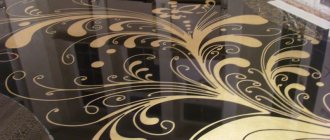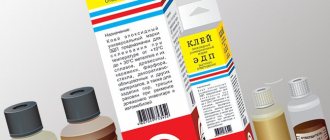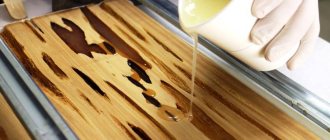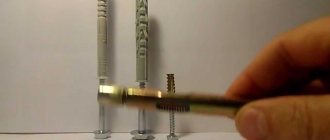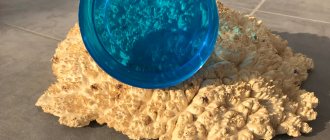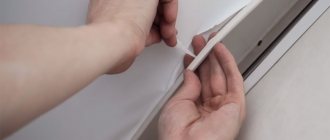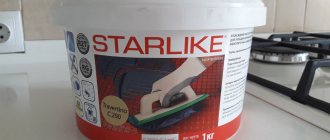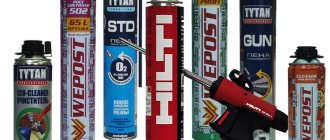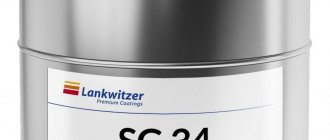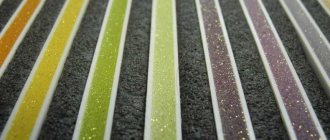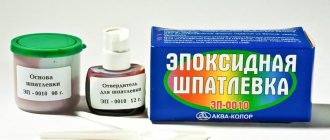The topic “epoxy resin”, strange as it may seem to some, upon closer examination may turn out to be comparable to the topic “steel”!
Epoxy resins should be understood as soluble and fusible reactive oligomeric products containing more than one epoxy group (hence the name), capable of transitioning to a thermosetting (hardened, infusible and insoluble) state under the influence of various types of curing agents.
Dozens of varieties of resins themselves are produced. And dozens of hardeners.
The epoxy group can react with more than 50 different chemical groups and there are several different polymerization mechanisms.
Some hardeners start the reaction as a result of catalytic action, others take a direct part in the chemical reaction.
The combination of these facts results in a wide variety of existing formulations, reaction conditions and a variety of properties of the final product - the cured resin.
Depending on the brand of resin, its softening temperature can be from 5°C to 150°C; accordingly, the reactive groups make up from 25% to 1.3% of the mass of the entire molecule. A completely similar situation occurs for hardeners.
The reaction produces heat, but additional components in the formulation can greatly influence its intensity.
Uncured resin irritates the skin. During the reaction, a complex of volatile substances may be released (primarily depending on the hardener): epichlorohydrin (the leading volatile component), as well as toluene, phenol, formaldehyde, resorcinol, aniline, diethylene glycol, etc. Although there are also formulations that do not emit volatile substances.
Therefore, you need to work in rubber gloves, in a room with good ventilation. Especially if you have to do this more than once a week.
In case of contact with skin, first rinse with acetone.
It is better to adjust surfaces “according to the nut principle”: carefully along the perimeter of the fit, inside there is a rough, embossed surface.
This allows you to transfer the load on the seam from the weakest link - shear along the gluing plane (and there is no plane!) - to the shear volume of the resin, which is much more difficult to do even in conditions when the shear strength of the seam is maximum.
Naturally, the surfaces must be prepared for gluing. Degrease, dry, sand.
The most common "cold cure" formulations at normal temperature gain from 60 to 80% of the final strength after 24 hours.
Final curing can be considered to be achieved after 72 hours at 20°C.
This will continue over the next few weeks, eventually reaching a point where further curing is impossible without a significant increase in temperature.
To increase the completeness of curing and, therefore, improve the properties of the resin, heat treatment can be carried out at 60-120°C for 12-2 hours.
The speed is determined by the composition of the resin and the composition of the hardener.
The reaction rate depends on temperature (approximately doubles for every 10°C).
A mixture of components taken at room temperature and self-heated to 50°C will harden much faster than a mixture of components heated to the same 50°C and preheated to 45°C.
A mixture that hardens at 20°C in an hour will harden at 30°C in half an hour. But at 10°C it will harden. when it warms up to 20°C. Since not only the speed, but also the completeness of the reaction depends on temperature.
However, there are formulations that can harden even at -10°C.
And vice versa - stable under storage conditions, but hardening at 120-150°C in 2-0.5 hours.
If you decide to work with a large amount, immediately after mixing you need to pour it into more or less small portions - otherwise you may not have time to spread it due to self-heating and accelerating the reaction.
For each recipe, the critical volume is different - until there is no excessive self-heating.
Some resins can be kneaded in a liter, while others, even in such a small volume as 20 g, can self-heat from an initial temperature of 20 °C to more than 200 °C!
The greater the danger of self-heating, the lower the viscosity of the components at room temperature and the larger the volume taken.
The reaction speed depends on the “form factor”: For example, if 100 g of a mixture of resin and hardener turns into a solid state in a glass in 15 minutes at an initial temperature of 25°C, then at the same 25°C these 100 g are evenly spread over an area of 1 m2, will harden for more than two hours.
For many formulations, contact with water on an uncured surface will produce a whitish film that will not harden and will have to be removed mechanically.
At the same time, there are formulations in which water can act as an accelerator. But even there already
1% water may cause foaming.
Heating of components and resin.
Heating the components or mixture simultaneously facilitates mixing, reduces the likelihood of the formation of air bubbles and accelerates the development of strength.
Large quantities can be heated by placing closed containers with ingredients in hot water or even in the microwave - if you have to work a lot and don’t mind the stove.
When working with small quantities, it is easier to heat at the same time as mixing.
Some people prefer not to heat in a water bath - there are no restrictions on the dishes, but there is a risk of water getting into the mixture.
I prefer to knead in aluminum drink caps (after removing the plastic gasket) on a cooling electric stove - you can start as soon as the splashes of water stop boiling on it.
When mixing small portions (several ml), the issue of exact dosage becomes more acute. Usually 1:10, see packaging for details.
It is recommended to maintain the required ratio of resin and hardener.
When working with the usual brand of resin, volumes and containers, you can “by eye”, based on the calculation that 1 ml of hardener is 20 drops.
By weight - it’s possible, but it’s a pity for the scales.
For more accurate dosing, you can pull the resins into a disposable syringe with the needle removed, put the needle on, and add the required amount of hardener.
Then everything is squeezed out (without a needle) into a mixing container and mixed with the same needle or match.
There is no need to rush when mixing the resin, especially when mixing at room temperature - air bubbles may become trapped. The smallest ones are especially unpleasant (the resin looks cloudy) - it can be difficult to get rid of them even when the mixture is heated.
After mixing, we again draw it into the syringe, from which we dose it locally. If necessary, we plug the syringe with “what was in the way.”
Unused residues can be left for a while as a “tester” to control the completeness of hardening.
An alternative dosing method is to cut the same syringe, turning it into a disposable beaker.
It is convenient to mix slightly larger portions in caps from aerosol cans.
The container is reusable - dried resin easily comes off the polyethylene.
Some people like to knead with a spatula on a polyethylene or fluoroplastic plate - you can spread a thin layer on it to delay hardening.
With a noticeable “skew” in any direction, the strength of the resin drops – down to a gel-like state. A slight deviation towards excess hardener will increase the completeness of the reaction when working with small portions at room temperature.
In addition, a resin with an excess of hardener becomes corrosive and everything suffers from it, including aluminum and stainless steel, especially if the resin is used to coat metal - there are cases when, in a couple of years, the bottom of a passenger car has corroded almost right through.
I came across epoxy packaged in aluminum tubes - it turned out that the hardener is a suspension of dark green powder and some kind of liquid.
When working with small quantities, precise dosing proved impossible.
If the hardener is of questionable quality or is from a different resin, you can conduct a rapid test. Dip a match into the mixed resin, heat [with another match, avoiding the resin getting into the flame] until it begins to boil. The resin should harden.
The testing skill can be practiced on mixtures that are known to be healthy.
In addition to the actual gluing, epoxy can be used to fill internal volumes.
Read also: DIY feather removal machine from a washing machine
If you want to slightly reduce the resin consumption, you can add filler to it.
Practically – almost anything, as long as it’s dry. From aluminum powder and flour, sawdust and metal and wood, to all kinds of pigments, watercolors, printing inks, toner (working off), cement.
It is better to introduce the filler after mixing the resin with the hardener - the risk of incorrect proportions is reduced. The hardener is usually much less viscous and more prone to absorption/concentration on the surface of filler particles.
On the other hand, the same resin can be used for external treatment of wooden handles.
By diluting with acetone/alcohol, we obtain impregnation.
Diluted mixtures have greater shrinkage, slightly lower strength, and can become porous when dry.
Without dilution, but preferably with heating - a durable varnish coating.
If desired, the resin can also be painted with oil paints. The coating is less hard and more flexible.
In addition, any vegetable oil can be used for plasticization - up to several percent of the volume. Adjusted for whether it dries out.
And if the drying coating is “breaded” in “extra” brand salt, sand the dried coating and wash the salt - our answer to the skin of an overseas stingray.
Tertiary amines, for example: dimethylaniline, can be used as an accelerator.
To dissolve a mixture that has not yet hardened and to slow down the reaction, acetone, ethyl methyl ketone, toluene, xylene, dioxane, and dimethylformamide can be used.
When you try to make a large amount of epoxy glue (putty) at once, it (she) instantly “boils” and hardens. If, before introducing the hardener into the epoxy glue (putty), you add 10-20% (by weight) of acetone (methyl acrylate, turpentine), then the likelihood of “boiling” will be much less. But if you cool the dishes vigorously, this will not happen at all. When it is necessary to make putty from glue, one of the fillers is mixed in it: calcium carbonate, aluminum powder (PAK), dry kaolin, mica, aluminum oxide, iron oxide, talc, graphite, quartz dust (marshallite) or quartz sand. Epoxy does not stick to plexiglass (polyacrylate). Craftsmen take advantage of this, creating, for example, stacked tabletops from wood slices. Slices of wood of various species are glued to a sheet of plexiglass with starch paste. Framing is laid around the perimeter. Everything is filled with eloxide tinted in the desired color. After hardening, the tabletop is separated from the plexiglass. Epoxy is painted by mixing it with dry gouache, artistic oil paints, ballpoint pen paste, and colored nitro paints. Mixing small amounts of water into epoxy produces milky streaks. The combination of epoxy with coal tar varnishes (pitch, asphalt bitumen, etc.), as well as with rubber compositions soluble in turpentine (acetone), makes it possible to obtain waterproof coatings for basements, foundations, etc.
Epoxy resins are versatile due to their low shrinkage, good chemical and thermal resistance, extremely high bond strength and good adhesion to most materials.
In terms of strength indicators, epoxy resin curing products are superior to all polymer materials based on other synthetic resins used in industry.
Cured epoxy resins are resistant to hydrochloric and sulfuric acids of medium and low concentrations, to alkalis and gasoline, and have good heat resistance and water resistance.
The hardened resin can withstand prolonged heating up to 150-180°C. with minimal loss of strength.
Special compositions can withstand up to 400°C for a short time and long-term operation in air at 250°C.
Tensile strength (for compositions based on epoxy resins without filler) can reach 400-1400 kgf/cm2, compression 1000-4000 kgf/cm2, bending 800-2200 kgf/cm2, elastic modulus 25000-50000 kgf/cm2, impact viscosity 5-25 kJ/m2, or kgf•cm/cm2, relative elongation 50-750% (test temperature 20 °C).
The strength of the adhesive joint can exceed 350 kg/cm2 in shear and approach the tensile strength of the resin itself.
Naturally, not all record indicators are achieved in one recipe.
Of the large number of materials that we encounter, epoxy does not cope well only with materials that are generally difficult to glue - nylon and, especially polyethylene, fluoroplastic. Well, highly elastic, non-porous materials.
When gluing various materials, especially non-porous ones, it must be taken into account that there is a tendency to greater (compared to resin in volume) fragility at the border with metal and to viscosity at the border with plastics.
Epoxy resin does not like sunlight, but this can only matter if it is used as a varnish and if the product will be constantly lying in the sun for years.
If we could also supplement it in terms of practical application and various tricks, well, for example:
1) The idea is not mine, I don’t remember someone from the forum, for which I thank him, I gave him advice - by mixing epoxy by eye (well, this happens) you can check its suitability like this: dip a match in glue, use another match to heat the resin at a distance so that it (a drop of glue on the first match) boiled, but did not char, that is, it foamed slightly, and we immediately stopped heating. If the drop has hardened, the proportion is guessed; if not, you need to add a hardener. I use it myself and recommend it to everyone.
2) Acetone, alcohol and nail polish remover dilute the resin indefinitely, but it must be taken into account that the amount of diluting liquid directly increases the final polymerization time and causes shrinkage, which can lead to surface deformation (particularly when making micarta). It is advisable to add thinners after checking the quality of the resulting glue using the “match” method. When mixing a large amount of resin, you can immediately dilute the resin, then add a hardener to the solution, but the proportion of resin and hardener must be checked in advance; this method will significantly reduce the likelihood of self-heating of the resin.
PS I dilute the epoxy in a 20 gram medical grade polyethylene cup. There were never any misses. First I pour the hardener, then the resin. I stir it with a bamboo kebabs skewer, a bunch of which cost three rubles, a useful and versatile household item.
Epoxy resin
— oligomers containing epoxy groups and capable of forming cross-linked polymers under the influence of hardeners (polyamines, etc.). The most common epoxy resins are products of polycondensation of epichlorohydrin with phenols, most often with bisphenol A. Resins based on bisphenol A are often called epoxy-diane in honor of the Russian chemist A.P. Dianin, who first obtained bisphenol A [1].
Properties [edit | edit code ]
Epoxy resins are resistant to halogens, some acids (strong acids, especially oxidizing acids, have poor resistance), alkalis, and have high adhesion to metals. Depending on the brand and manufacturer, epoxy resin appears as a clear yellow-orange liquid, reminiscent of honey, or as a brown solid, reminiscent of tar. Liquid resin can have a very different color - from white and transparent to wine red (for epoxidized aniline).
Pure, unmodified resin without fillers has the following properties:
- elastic modulus: E ≈ 3000 − 4500 N mm 2 < m >< m <^<2>>>>>;
- tensile strength: R ≈ 80 N mm 2 < m >< m <^<2>>>>>;
- density: ρ ≈ 1, 2 gcm 3 ho approx 1<,>2< m >< m <^<3>>>>>.
Although epoxy resin cured using the correct technology is considered absolutely harmless under normal conditions, its use is greatly limited, since when cured under industrial conditions, a certain amount of sol fraction remains in the resin - a soluble residue. It can cause serious health damage if it is washed away with solvents and enters the body. In their uncured form, epoxy resins are quite toxic and can also be harmful to health.
Regular formulations
However, the described resins are difficult to produce, require special reactor boxes for curing, and fireproof molds in which these castings are made, so they are of little interest to the mass consumer, and are also extremely expensive. More interesting for him would be ordinary resins of the ED class or its analogues, in which non-standard substances were used for curing, and even with the introduction of plasticizer fillers into them, increasing heat resistance.
The greatest demand for heat-resistant materials made from epoxy resins is observed among car and motorcycle enthusiasts. The stumbling block most often is the components of the connections in the mufflers, which quickly burn out. This is where the heat resistance of products made from epoxy or materials with it can be enhanced by reinforcing the gaskets with carbon fiber or even ordinary fiberglass.
With the introduction into the hardening resin at the joints or gaskets of an additional reinforcing and cementing element in the form of fine steel filings or even aluminum powder, which, when combined with the resin, perfectly holds temperatures up to 340°C degrees. True, the impact strength of such a resin suffers.
Resins with fillers, and even more so reinforced ones, are even more difficult to melt. We can only talk about their gradual charring and destruction.
If we talk about the complete melting of epoxy materials when exposed to high temperatures, then it is only possible with alternating exposure to fast-acting caustic solvents and high temperatures. Then, along with physical changes in the crystal lattice of the polymer, a chemical weakening of intermolecular bonds will also occur.
Obviously, the operating temperature of epoxy resin has a wide range. It all depends on the polymer composition and additives added to it.
Modification [edit | edit code]
Epoxy resins can be modified. A distinction is made between chemical and physical modification.
The first is to change the structure of the polymer network by adding compounds that are built into its composition. As an example, the addition of laproxides (polyethers of alcohols containing glycidyl groups, for example, glycerol anhydride), depending on the functionality and molecular weight, gives the cured resin elasticity by increasing the molecular weight of the interstitial fragment, but reduces its water resistance. The addition of halogen and organophosphorus compounds makes the resin more inflammable. The addition of phenol-formaldehyde resins allows the epoxy resin to be cured by direct heating without a hardener, gives greater rigidity, improves anti-friction properties, but reduces impact strength [2].
Read also: Which radio components contain palladium
Physical modification is achieved by adding substances to the resin that do not enter into a chemical bond with the binder. As an example, adding rubber can increase the toughness of the cured resin. The addition of colloidal titanium dioxide increases its refractive index and makes it opaque to ultraviolet radiation [ source not specified 1389 days
] .
Epoxy resin grades
Epoxy resins mainly differ in the thickness of the composition, with a standard consistency of the mixed constituents. If previously resins were produced only for industrial use and were very toxic in composition, today some companies produce environmentally friendly resins for home use.
QTP-1130
Low-viscosity, solvent-free resin. Well suited for beginners creating small designs. Has high transparency. Often used when pouring countertops made of slab, stone or various decor. Does not turn yellow. Fills the filling mold evenly and does not shrink.
Characteristics:
- Compressive strength – 83 MPa;
- Tensile strength – 50 MPa;
- Bending strength – 79MRa;
- Heat resistance: + 50 degrees with constant exposure, +80 with exposure for up to 7 days, +100 degrees with exposure for up to 12 hours.
QTP-1130 resin is non-toxic after drying. Does not have an unpleasant chemical odor in liquid form. Recommended for use at temperatures up to + 40 degrees.
Art-Eco
Two-component, low-viscosity resin. To reduce viscosity, it is equipped with a solvent. The maximum thickness for pouring is 7 mm. Well suited for mixing with color. One of the disadvantages is the need to strictly adhere to the proportions of mixed elements. Suitable for pouring monolithic structures and coatings, for making countertops and jewelry.
- Compressive strength – 80;
- Tensile strength – 40;
- Bending strength – 70.
Art-eco is resistant to light, heat up to +70 degrees and mechanical damage. Very transparent, but turns yellow over time. Use with color is mandatory. The resin has no pungent chemical odors, both in liquid and solid form.
ED-20
Resin for universal use. It is manufactured according to GOST, therefore in many respects it does not fall under modern characteristics. It is highly viscous, which greatly complicates working with it. Air bubbles often appear. It is extremely difficult for beginners to work with this resin. Over time it turns a little yellow, the use of color is mandatory. The main advantage of the composition is its high strength and resistance to mechanical stress.
- Compressive strength – 85;
- Tensile strength – 90;
- Bending strength – 140.
This epoxy resin has many fans and opponents. Mostly negative reviews arise due to inexperience when working with ED-20.
CHS Epoxy 520
Epoxy resin from Czech manufacturers. It is the most transparent in consistency of all brands on the market. The best choice when creating products with a lot of complex decor. When decorating, it is possible to use dry and fresh flowers and leaves, metal, wood, stones. When mixed with hardener grade 921, OP becomes highly plastic. The ductility of the finished countertop is very important, since the load may be uneven. CHS Epoxy 520 is an analogue of domestic resins of the ED20 and ED 22 brands. But it is easy to use. After application, there are no air bubbles and the composition does not turn yellow over time.
- Compressive strength - 80;
- Tensile strength – 75;
- Bending strength – 92.
This brand of resin is suitable for both beginners and professionals. Very well suited for creating large countertops. The pouring depth is 1.5 - 2 centimeters for the first layer.
Crystal Glass
Resin from a domestic manufacturer. Suitable for filling small structures and jewelry, as well as large-volume countertops. It is very easy to work with this brand, since its fluidity depends on the amount of hardener. A special feature of CrystalGlass is the need to infuse before pouring. During infusion, the composition thickens, which allows you to find the required level of thickening. The resin spreads very well and fills the entire relief of the workpiece and decorative elements. Does not form bubbles or cloudy flakes. The hardened countertop is durable, corrosion resistant and will not yellow over time. You can add color to CrystalGlass.
- Compressive strength – 75;
- Tensile strength – 70;
- Bending strength up to 85.
CrystalGlass is one of the brands of epoxy resins suitable for beginning countertop makers. When working with it, you only need to choose the correct consistency of the viscosity of the composition.
PEO-610KE
Another brand of resin manufactured in accordance with GOST. The letter “E” indicates a high degree of elasticity of the hardened composition. This makes it possible to produce large countertops with a large margin of safety. The pouring depth of one layer is 0.7 cm. in this case, the composition completely hardens after 54 hours. The PEO-610KE compound allows you to fill complex decorative elements without the appearance of unevenness, bubbles and voids. The finished tabletop has a tensile strength of up to 75 MPa and a bending strength of up to 90 MPa. Does not turn yellow, does not have an unpleasant chemical odor. Has high moisture-repellent ability. There is no hardener included with the main component. It must be purchased separately. The resin is easy to use and allows even beginners to work with ease.
EpoxAcast 690
Also domestic epoxy resin. It has high transparency and rigidity in the solid state. Not plastic. When working with it, you can fill up to 5 cm of the first layer. Subject to shrinkage as it hardens. More suitable for making jewelry. When creating monolithic structures of large volumes, certain experience is required. Bending strength up to 140 MPa, tensile strength 120 MPa. With its increased ductility and low elasticity, EpoxAcast 690 can be used to fill decorative elements of medium complexity. The material does not turn yellow, but can be added to the color composition. Does not have an unpleasant odor.
MG EPOX STRONG
Super transparent resin from Germany. The most popular filling composition among professionals. It has high transparency, does not turn yellow and does not shrink. Allows you to work with complexly decorated structures of large volumes. Does not permeate layers of sand and does not separate grains of sand. Great for filling photos, flowers and leaves while maintaining vibrant colors. Hardens within 3 days. During this time, it acquires strength up to 90 MPa and bending elasticity up to 85 MPa. Many craftsmen recommend making countertops and structures with increased strength requirements with this particular brand of resin.
Epoxy CR 100
The most harmless resin in terms of chemical composition. It is recommended as a universal resin for working with small models and jewelry, as well as for making countertops. Suitable for filling slabs, complex decorative elements and photographs. It has high solid strength and high transparency. Does not turn yellow and allows you to add color to the composition. Hardens within 50 hours. Not subject to corrosion, ultraviolet radiation and moisture accumulation. Suitable for beginners due to ease of use and liquid consistency without the appearance of microcracks and bubbles.
When choosing an epoxy resin, it is important to know all the nuances of its state in liquid and solid states. Before starting the main work, you need to practice mixing and achieving the correct consistency.
It is important to read the accompanying instructions very carefully.
Receiving [edit | edit code ]
Epoxy resin was first obtained by the French chemist Castan in 1936 [1].
Epoxy resin is produced by polycondensation of epichlorohydrin
with various organic compounds: from phenol to edible oils, for example, soybean [
source not specified 1389 days
]. This method is called “epoxidation”.
Valuable grades of epoxy resins are obtained by the catalytic oxidation of unsaturated compounds. For example, this is how cycloaliphatic resins are obtained, valuable because they contain absolutely no hydroxyl groups and are therefore very hydroresistant, tracking- and arc-resistant.
For practical use of the resin, a hardener is needed. The hardener can be a polyfunctional amine or anhydride, sometimes an acid. Curing catalysts such as Lewis acids and tertiary amines, usually capped with a complexing agent such as pyridine, are also used. After mixing with a hardener, the epoxy resin can be cured - converted into a solid, infusible and insoluble state. If it is polyethylene polyamine (PEPA), then the resin will harden within a day at room temperature. Anhydride hardeners require 10 hours of time and heating to 180 °C in a heat chamber (and this does not take into account cascade heating from 150 °C).
Helpful tips when working with epoxy
Temperature is one of the important and fundamental factors when working with epoxy resins. Therefore, when using a resinous substance, be sure to adhere to the recommended conditions. Ideally, in the room where the polymerization process and epoxy pouring takes place, the temperature should be between +24⁰–30⁰С. Other recommendations should be followed:
- the workroom should be not only warm, but also dry;
- the ingredients (resins and hardener) are kept in hermetically sealed packaging until they are mixed;
- when mixing the mixture, a hardener is added to the resin, and not vice versa;
- when adding a catalyst, the epoxy can be slightly heated to +40⁰–50⁰С;
- the standard time for the first polymerization of the resinous substance is 1 day at a temperature of +24⁰С;
- the period for gaining maximum strength is up to a week;
- when mixing too large doses of resin and hardener, the epoxy may boil and lose its working properties.
Traditional Applications
Shrinkage when using ED-20 is very small. In addition, as we found out, this product polymerizes quite quickly. Thanks to these properties, this material has found very wide application both in industry and in construction or everyday life. ED-20 resin, the technical characteristics of which make this product almost universal, can be used, for example:
for repairing various types of electrically powered equipment;
- in instrument making;
- in the aviation industry;
- furniture industry;
- when repairing car structural elements;
- in the radio engineering industry.
This material is also widely used by designers. It can be used to create, for example, countertops, haberdashery, and various moisture-resistant products intended for use in bathrooms. Epoxy is also used for priming various types of surfaces.
Another area of use of ED-20 is the production of enamels, varnishes, and putties. Other brands of epoxy resins are also made using this material. In everyday life, this material is often used as glue. With its use, it is possible to fasten both wood and metal, plastic, ceramics, and glass.
How to use and what temperature it can withstand
When repairing ceramic products, glue hides places of damage and breakage. Dirt is removed from the broken elements and degreased, then a layer of epoxy is applied and the product is joined into a single piece.
This composition is used for concrete structures in order to obtain protection from water and moisture, fill joints that do not change when hardened, and withstand temperature changes.
Car owners use epoxy glue for quick repairs so that they can get to the service station.
It is this glue that glues wooden products into strong joints.
During the connection process the following actions are performed:
- Tools are being prepared.
- The bonded surfaces are processed to improve adhesion (remove dirt, sand, degrease, dry).
- The adhesive composition is applied to the plane in a thin layer.
- Combine the components to be glued and secure.
- Tight fixation is necessary for 10 minutes.
- Put into operation within a day.
We eliminate the causes and their consequences
When epoxy resin interacts with different types of hardener, different substances can be obtained. They vary in strength and elasticity. And also in softness and elasticity. By combining the base substance and the hardener in different ways, varying their concentrations, a polymer with different characteristics is obtained.
However, with any combination of constituent components, the resin must be completely dry before applying subsequent layers to the epoxy resin. The composition does not harden for several probable reasons. You should understand them in detail to prevent difficulties when using the material.
Error in the proportion of components
Due to insufficient or excessive amounts of hardener, the result is often disrupted. A sticky and incompletely hardened layer that does not “set” for more than a day will have to be removed. Subsequent layers are not applied to undried epoxy resin.
To obtain an ideal coating, it is necessary to strictly observe the proportions. And an increase or deficiency of any of the components negatively affects the final result.
When reapplying the composition, you should check the ratio of hardener and epoxy resin. It is better not to add excess hardener to the already prepared solution. It is more correct to prepare the composition according to the proportions indicated in the instructions.
Incorrectly selected temperature mode
The mixture hardens at room temperature. However, the resulting coating will dry faster if the ambient temperature is increased. The effectiveness of the “setting” of epoxy resin largely depends on this factor.
In cool weather, the polymerization reaction time increases. Which entails an increase in the drying time of the composition. When the ambient temperature decreases by 10°C, the polymerization time increases by 10-15 hours.
What should I do? The following tips will help you maintain the desired curing rate:
- Curing will proceed faster if the temperature is maintained. If necessary, from an external source;
- if it is not possible or difficult to maintain the temperature at the proper level, you can initially use a hardener designed to work at low temperatures to prepare the mixture.
According to those who use epoxy resin, there are better brands. For certain conditions, it is better to choose the appropriate version of the substance. AF-2 should be considered the best domestic brands of hardeners that “work” at low temperatures. And the best slow hardener is the DTB-2 brand.
Epoxy resin and hardener do not mix thoroughly
The most common mistake made, which entails a decrease in the rate of hardening of the composition, is insufficient mixing of the components. The reason for the lack of rapid hardening of epoxy resin is that it was not mixed for too long and thoroughly. And this happens due to an incomplete polymerization reaction. Indeed, it is as a result of this that the shape of the liquid substance changes: the resin gives a durable and beautiful solid layer and ceases to be sticky.
To make a uniform composition, it is necessary to mix the mixture in the correct quantities. The epoxy resin and the selected type of hardener must be mixed thoroughly. Mixing should be carried out until the composition is completely homogeneous. There should be no places left in the resulting solution where there is a clear predominance of one of the components.
If it is planned to introduce additives or fillers into the composition (for example, a silicone filler that improves the final result), they should be used only after thoroughly mixing the mixture.
The situation can be corrected only by deleting the unsuccessful layer. A new mixture is prepared. And its components are thoroughly mixed and applied to the prepared surface.
Incorrect selection of components
It is better to use a different hardener for each type of epoxy resin. This will eliminate the risk of prolonged hardening of the composition. It also improves the properties of the resulting coating. The same applies to the polyester resin catalyst. It must be selected in accordance with the type of epoxy.
When taking into account the listed factors when preparing a mixture based on epoxy resin, a high-quality coating is obtained. Under favorable conditions, it dries in no more than one day.
Criterias of choice
The modern market offers a huge range of compounds designed for working with metals, including heat-resistant ones. You can draw your own conclusions regarding quality after using the glue.
Some caution should be exercised when considering compounds classified as universal. Therefore, pay special attention to what components are in it. Also take a look at:
- The temperature range at which the glue does not lose its beneficial properties. Find out under what conditions the finished elements will be used and whether they require additional processing. If yes, at what temperatures?
- Drying period . This parameter completely depends on the characteristics of the application process and the workplace.
- Application method. Remember that it can be different: some materials are glued point by point, others need to be completely processed. In the latter case, glue consumption will increase.
- Application technologies. They have differences. Ask a sales consultant for advice and make sure that the composition will be easy to use.
- Consistency. Any adhesives go on sale in several versions: tubes or plastic sticks. In the first case, you will have to make a mixture of two components yourself, which is not always convenient or possible. Ready-made formulations are distinguished by their ease of use.
- Level of resistance to liquids and aggressive environmental influences. This parameter is especially important if the components to be glued are located outdoors.
- What materials can be bonded with? Select specific compounds to perform specific tasks.
